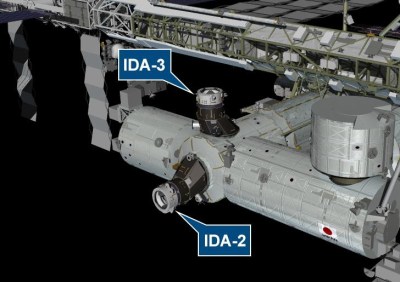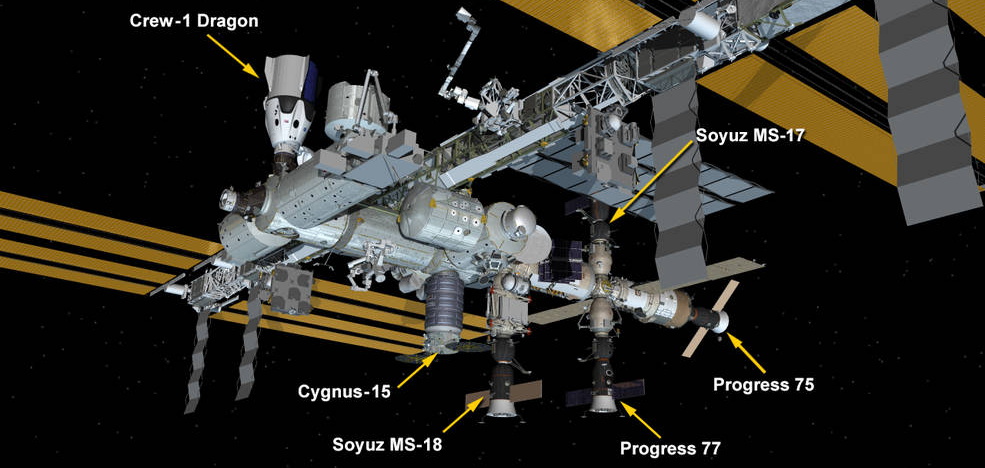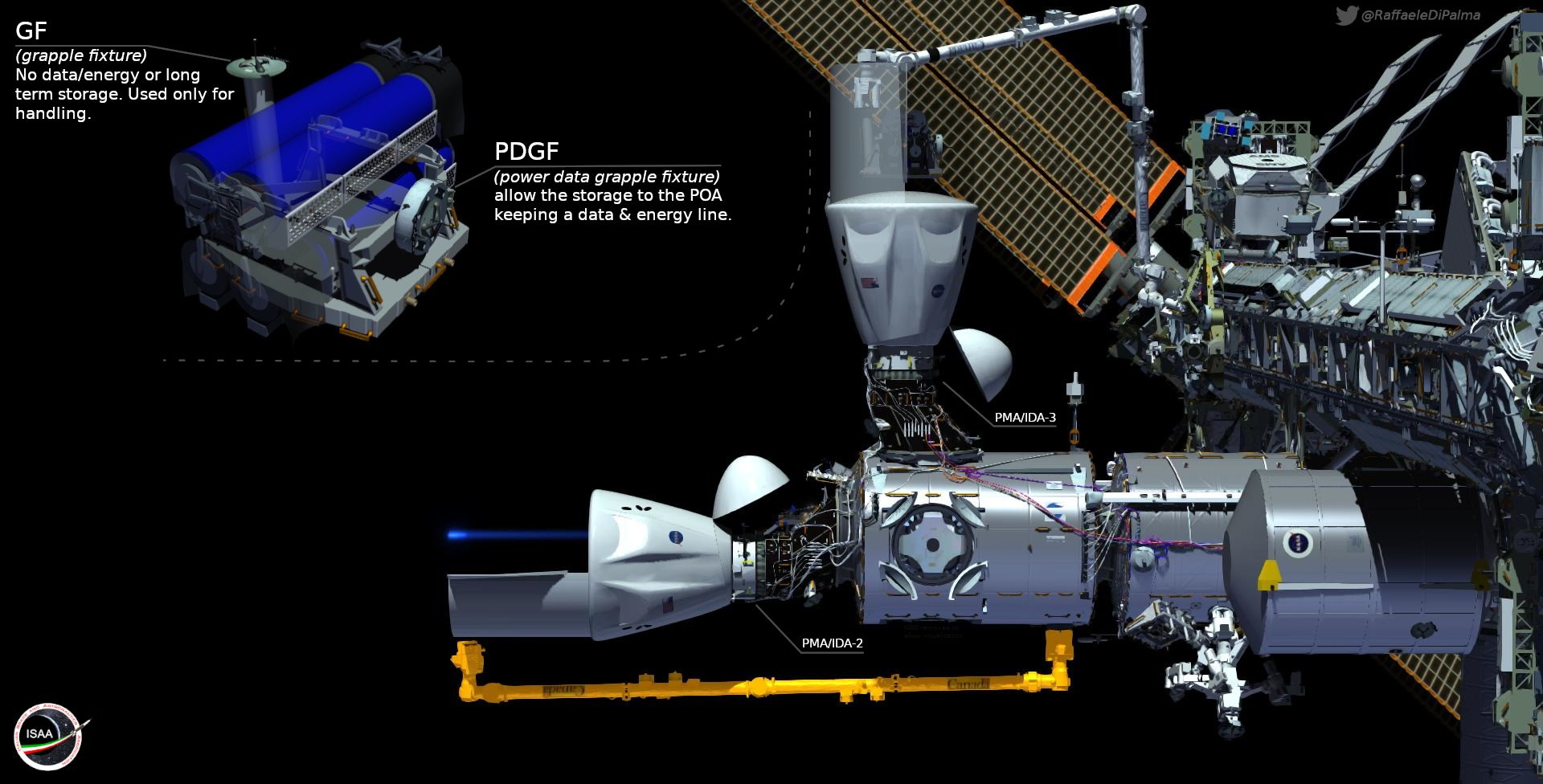They weren’t scheduled to return to Earth until April 28th at the earliest, so why did NASA astronauts Michael Hopkins, Victor Glover, and Shannon Walker, along with Japan Aerospace Exploration Agency (JAXA) astronaut Soichi Noguchi, suit up and climb aboard the Crew Dragon Resilience on April 5th? Because a previously untested maneuver meant that after they closed the hatch between their spacecraft and the International Space Station, there was a chance they weren’t going to be coming back.
On paper, moving a capsule between docking ports seems simple enough. All Resilience had to do was undock from the International Docking Adapter 2 (IDA-2) located on the front of the Harmony module, itself attached to the Pressurized Mating Adapter 2 (PMA-2) that was once the orbital parking spot for the Space Shuttle, and move over to the PMA-3/IDA-3 on top of Harmony. It was a short trip through open space, and when the crew exited their craft and reentered the Station at the end of it, they’d only be a few meters from where they started out approximately 45 minutes prior.
 The maneuver was designed to be performed autonomously, so technically the crew didn’t need to be on Resilience when it switched docking ports. But allowing the astronauts to stay aboard the station while their only ride home undocked and flew away without them was a risk NASA wasn’t willing to take.
The maneuver was designed to be performed autonomously, so technically the crew didn’t need to be on Resilience when it switched docking ports. But allowing the astronauts to stay aboard the station while their only ride home undocked and flew away without them was a risk NASA wasn’t willing to take.
What if the vehicle had some issue that prevented it from returning to the ISS? A relocation of this type had never been attempted by an American spacecraft before, much less a commercial one like the Crew Dragon. So while the chances of such a mishap were slim, the crew still treated this short flight as if it could be their last day in space. Should the need arise, all of the necessary checks and preparations had been made so that the vehicle could safely bring its occupants back to Earth.
Thankfully, that wasn’t necessary. The autonomous relocation of Crew Dragon Resilience went off without a hitch, and SpaceX got to add yet another “first” to their ever growing list of accomplishments in space. But this first relocation of an American spacecraft at the ISS certainly won’t be the last, as the comings and goings of commercial spacecraft will only get more complex in the future.
Unprecedented Activity
During the Space Shuttle years NASA didn’t have to worry about relocating their spacecraft, as there was never more than one of the winged orbiters in space at the same time. But since the Shuttle was capable of simultaneously carrying seven crew members and an incredible amount of cargo, this wasn’t a problem. All of NASA’s operational needs on the ISS were more than met by a single vehicle.
Of course, all that changed when the Shuttle was retired in 2011. NASA began making deals with its international partners, and eventually even commercial companies, to bring crew and cargo to the Station on a wide array of smaller and more operationally nimble spacecraft. Today these vehicles, in addition to Russia’s Soyuz and Progress spacecraft, occupy most of the available docking and berthing ports on the ISS at any given time. In the coming years even more commercial spacecraft are expected to be brought online, meaning traffic is only going to get worse at the orbiting outpost.

With the US segment of the ISS now busier than ever, NASA is faced with a logistical challenge that their Russian counterparts are already well accustomed to. This may have been the first time an American spacecraft had to be relocated to another docking port during a mission, but to date, 19 Soyuz capsules have had to make similar treks; the most recent of which having just occurred a few weeks prior on March 19th.
A Complicated Dance
Given that Resilience ended up moving to a docking port that’s only a few meters away from where it was originally, it’s easy to think the whole thing was some kind of experimental proof of concept. Perhaps as a test for future, more complex maneuvers. But in fact, the two International Docking Adapters are currently the only spots on the ISS where commercial vehicles such as the Crew Dragon, Boeing’s Starliner capsule, and eventually Sierra Nevada’s Dream Chaser spaceplane, can attach. In short, while the destination will alternate, port relocations for US spacecraft will always be a short hop.
But why? What difference could a trip of such a short distance make? The answer lies in the unique design of the Dragon’s Cargo variant, which is able to carry large bulky objects in the hollow “trunk” behind the pressurized capsule. Generally speaking cargo brought up in the rear of the Cargo Dragon is intended to be mounted to the outside of the Station, and is retrieved from the spacecraft using the orbiting laboratory’s robotic arm. As it so happens, this is how both IDA-2 and IDA-3 were delivered to the Station in 2016 and 2019.
The trick is, Station’s arm can’t reach into the trunk of the Dragon if it’s docked to Harmony’s forward port. That’s not a problem currently, as Resilience isn’t carrying any external cargo. But it will be in June, when a Cargo Dragon delivers a new set of deployable solar arrays for the Station as part of the CRS-22 mission . To further complicate matters, another four astronauts are slated to dock with the Station at the end of April aboard Crew Dragon Endeavour.

That meant Resilience needed to move to PMA-3/IDA-3 so Endeavour can dock to PMA-2/IDA-2 at the end of the month. Then once Resilience leaves, the upper docking port will be free to accept CRS-22 in June so the solar arrays can be removed from its trunk with the robotic arm. After CRS-22 departs, Endeavour will need to make its own “up and over” hop to PMA-3/IDA-3, as a Boeing Starliner needs to dock at PMA-2/IDA-2 as part of its first test flight to the Station in July.
Sound complicated? That’s because it is. But unfortunately for NASA, unless plans for a commercial expansion to the International Space Station go through, this is the orbital game of “musical chairs” they’ll be forced to deal with. With only two viable docking ports available for current and future spacecraft, the United States should quickly catch up with their Russian counterparts when it comes to the fine art of spacecraft juggling. Except now those relocations will be autonomous.
















Put a multi-dock extension on the docking port, problem solved.
Do you prefer the Belkin or Star-Tech model?
The Russians had plans for a spherical hub module that could be used this way, turn one open port into 5 or what have you. But I think it was canceled, or at least, pushed back until they figure out what their post-ISS station will look like.
They need a few more Space Port 101s, Swizzels had it all planned out for them in 1979…
https://1.bp.blogspot.com/-YaKtgu6G1wc/XPRErIBaHrI/AAAAAAAAtY0/BpkOZVu5ZVo_GD1A6yCgi7TjSBV2myQVQCLcBGAs/s1600/NOTR.jpg
Great! Space is Getting much more Activity to help get ready fo multiple Moon Missions!!!!
Nice graphic, Joe Kim!
CRS-22
Catch-22?
Can’t Remember $H!+?
Anyway, I didn’t know the Draggin’ had a trunk/boot!
B^)
Comercial Resupply. I presume the 22nd one? Or maybe it’s like chip date codes and no one that doesn’t work there knows for sure :P
There are more than 2 docking ports available. The problem is that there are only two IDA ports available. There are open Common Berthing Mechanism ports that the first generation of Cargo Dragon used. The issue was created when SpaceX switched the cargo Dragon variant away from the CBM to the IDA.
EPIC., CBM to dual IDA adapter incoming?🤔
They’ll attempt docking, only to find they need to frustratingly back away and rotate 180° before trying again.
LOL!
Then realize they had it right the first time, and have to rotate 189 again.
Berthing ports are not docking ports, that’s the whole point. They could be converted to docking ports, but there are no plans to do so.
Not only would the loss of the berthing ports make potential expansion of the station harder, but there are still vehicles like Cygnus that use them.
I didn’t state that right. What I meant to say was that there are more attachment points available but only two of them are “docking” ports for the current generation of crewed vehicles. I understand why SpaceX might have wanted to switch away from the CBM with the necessity of being berthed by the robot arm and they did not want to continue supporting two totally different families of spacecraft. However, it has definite downsides, such as the inability to pass larger items (for instance some space suit hardware) through the smaller opening, and adding to the congestion of the two available docking ports. I don’t see this being mitigated any time soon. Adding another docking port would require adapting a CBM port, that would need something like another PMA (Pressurized Mating Adapter that the current IDA attaches to) and I do not know if Cargo Dragon is capable of lifting something that big. Adding more CBM ports would likely require a new Node, and since the Shuttle is gone I don’t know of any way for something like that to be launched, unless perhaps the Cygnus bus could carry a node in place of the logistics carrier. But again, size, weight, I don’t know.
It’s not possible to dock with the CBM. The CBM requires a capture and berth of the Dragon with the arm from the Station. The CBM is low impact and has little instrumentation for docking, so its functionality is not acceptable for a crewed vehicle.
Coders debate 0 and 1 indexing, but I’m guessing NASA didn’t start numbering ports from 2 so there’s probably a history on IDA-1?
IDA-1 was lost on CRS-7 launch.
Apparently IDA-1 was supposed to go where IDA-2 is: https://blogs.nasa.gov/spacex/2015/06/28/about-the-international-docking-adapter/